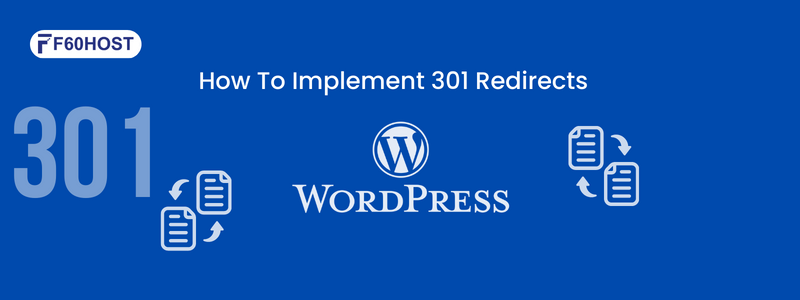How To Implement 301 Redirects In WordPress

Welcome to our beginner-friendly blog post on how to implement 301 redirects in WordPress! If you’re new to website management or unsure about what a 301 redirect is, don’t worry. We’ve got you covered. In this guide, we’ll explain the concept of 301 redirects, why they are important, and provide you with step-by-step instructions on how to implement them in your WordPress website. So, let’s dive in and make the process of redirecting your website smooth and hassle-free!
What is a 301 Redirect and Why is it Important?
If you’ve ever stumbled upon a broken link or clicked on a URL that led you to a dead end, you’ve experienced the frustration of landing on a page that no longer exists. This is where a 301 redirect comes to the rescue. A 301 redirect is a way to guide both search engines and visitors from an old, outdated URL to a new, updated one. It’s like providing them with a map to find their way to the right destination.
So, why is a 301 redirect important? Well, think of it as a crucial tool for maintaining a seamless online experience. Here are a few key reasons why implementing 301 redirects matters:
Preserve SEO Value:
Search engines, such as Google, consider links as votes of confidence for a website’s credibility. When you change your website’s URL structure or remove pages without proper redirection, you risk losing valuable SEO rankings. By using a 301 redirect, you can transfer the SEO value from the old URL to the new one, preserving your hard-earned rankings and ensuring that search engines can still find and index your content.
Enhance User Experience:
Imagine a visitor clicking on a link to your website from an external source, only to land on an error page. It’s not only frustrating for them but also reflects poorly on your brand. A 301 redirect ensures that visitors are seamlessly redirected to the correct page, minimizing any disruption to their browsing experience. By guiding users to the right content, you can keep them engaged, improve their satisfaction, and increase the chances of conversions.
Maintain Backlink Integrity:
Backlinks, or incoming links from other websites, are valuable for driving traffic and boosting your website’s authority. However, when you delete or move a page without a redirect, those backlinks can become broken, leading to a loss in referral traffic and potentially damaging your website’s reputation. By implementing a 301 redirect, you can ensure that those backlinks continue to direct visitors to the relevant content, preserving the flow of traffic and maintaining positive relationships with other websites.
Update Website Structure:
As your website evolves and undergoes changes, you may find the need to reorganize or rename pages. Without a redirect, any external links, bookmarks, or indexed search results pointing to the old URL would lead to a dead end. By utilizing a 301 redirect, you can seamlessly guide users and search engines to the new location, helping you maintain a well-structured website and preventing confusion or frustration for your audience.
In summary, a 301 redirect is a vital tool in your website management arsenal. It allows you to gracefully redirect users and search engines from outdated or broken URLs to the appropriate pages, preserving your SEO value, enhancing user experience, and maintaining the integrity of backlinks. By implementing 301 redirects, you can ensure that your website remains accessible, organized, and user-friendly.
Introducing popular WordPress plugins for managing redirects
Now that you know the importance of redirects, let’s see some plugin options that could help you.
Redirection:

One of the most widely used and highly regarded plugins for managing redirects is Redirection. This plugin offers a simple and intuitive interface that allows you to easily set up and manage 301 redirects directly from your WordPress dashboard. With Redirection, you can monitor 404 errors, track the number of times a redirect is used, and even import and export redirect rules. Whether you’re redirecting individual pages or entire site migrations, Redirection provides a comprehensive solution.
Yoast SEO Premium:

While Yoast SEO is primarily known for its powerful SEO features, the premium version of the plugin includes a redirect manager. If you’re already using Yoast SEO and want to streamline your website management, this plugin might be the perfect fit. Yoast SEO Premium enables you to set up redirects effortlessly, manage them alongside your SEO settings, and benefit from the plugin’s extensive knowledge base and support.
Simple 301 Redirects:

True to its name, Simple 301 Redirects is a lightweight plugin that focuses on providing a straightforward solution for redirecting URLs. If you prefer a no-frills approach and don’t need advanced features, this plugin is worth considering. With Simple 301 Redirects, you can easily redirect individual pages or bulk redirect URLs by simply entering the old and new URLs in the plugin’s settings. It’s a great option for those seeking simplicity and efficiency.
Safe Redirect Manager:

As the name suggests, Safe Redirect Manager prioritizes security and reliability. This plugin allows you to create and manage redirects while maintaining the integrity and security of your website. Safe Redirect Manager provides a user-friendly interface with advanced options such as redirecting by user roles or devices. It also ensures that the redirects are implemented safely, without exposing your website to any vulnerabilities.
Quick Page/Post Redirect Plugin:

If you’re specifically looking for a solution to redirect individual pages or posts, Quick Page/Post Redirect Plugin can be an excellent choice. This plugin offers an easy-to-use interface that allows you to set up redirects for individual pages or posts, with options to choose between 301, 302, or 307 redirects. With Quick Page/Post Redirect Plugin, you can effortlessly redirect outdated content to new URLs, keeping your website organized and user-friendly.
Take your time to explore these plugins, compare their features, and choose the one that best suits your needs. With the right plugin for managing redirects, you’ll be able to efficiently redirect URLs, maintain a smooth user experience, and keep your website optimized for search engines.
Steps To How to 301 Redirect Using Any Plugin
Redirecting URLs in WordPress becomes a breeze with the help of various redirect management plugins available. These plugins offer user-friendly interfaces and powerful features to simplify the process. In this section, we’ll walk you through the general steps to implement a 301 redirect using any plugin of your choice.
- Install and activate a redirect management plugin from the WordPress repository.
- Access the plugin’s redirect settings in the WordPress dashboard.
- Set up a new redirect rule within the plugin’s settings.
- Enter the old URL (the one to be redirected) and the new URL (the destination).
- Save the redirect rule and test it to ensure proper functionality.
- Repeat the process for additional redirects, if needed.
- Regularly monitor and update your redirects as your website evolves.
Manual Method: Implementing 301 Redirects in WordPress:
While using plugins can make the process of implementing redirects in WordPress easier, some website owners prefer a more hands-on approach. If you’re comfortable with editing files and want full control over your redirects, the manual method might be the way to go. In this section, we’ll walk you through the manual process of implementing 301 redirects in WordPress.
Accessing Your .htaccess File:
To begin, you’ll need to access your website’s .htaccess file, which is located in the root directory of your WordPress installation. You can do this through an FTP client or via your hosting provider’s file manager. Make sure to create a backup of the .htaccess file before making any changes.
Editing the .htaccess File:
Once you have access to the .htaccess file, open it using a text editor. Before making any changes, it’s crucial to familiarize yourself with the syntax and structure of 301 redirects. Each redirect rule follows a specific format:

In this example, “/old-url/” represents the URL you want to redirect, and “http://www.example.com/new-url/” is the destination URL where you want to redirect the traffic.
Adding Redirect Rules:
To implement a 301 redirect, add a new line to the .htaccess file for each redirect rule you want to create. Remember to follow the correct syntax, ensuring that the old URL and new URL are separated by a space. Here’s an example of how it should look:

Testing and Verifying Redirects:
After saving the changes to the .htaccess file, it’s crucial to test your redirects to ensure they are working correctly. Open a web browser and enter the old URL. It should automatically redirect you to the new URL. If it doesn’t, double-check your syntax and make any necessary adjustments.
Repeat for Additional Redirects:
If you have multiple redirects to implement, follow the same process for each redirect rule. Make sure to maintain a clear structure within the .htaccess file, separating each rule with a new line.
Upload the Updated .htaccess File:
Once you’re satisfied with the redirects you’ve added, save the changes to the .htaccess file and upload it back to your website’s root directory. Ensure that the new file replaces the existing one.
Regularly Monitor and Update Redirects:
As your website evolves, you may need to modify or remove existing redirects. Keep a record of your redirects and periodically review them to ensure they remain relevant. Regularly monitoring your redirects will help maintain a well-organized and efficient redirect system.
While the manual method requires a bit more technical knowledge, it offers you complete control over your redirects.
Remember, regardless of the method you choose, implementing 301 redirects in WordPress is essential for preserving SEO value, enhancing user experience, and maintaining the integrity of your website’s structure.
Impact on SEO and User Experience:
When it comes to managing redirects in WordPress, considering the impact on both SEO and user experience is crucial. Redirects play a significant role in maintaining a well-structured website, preserving search engine rankings, and ensuring a smooth browsing experience for your visitors.
SEO Impact:
Search engine optimization (SEO) is all about improving your website’s visibility and ranking in search engine results. Redirects, particularly 301 redirects, play a vital role in preserving the SEO value you’ve built over time. When you delete or move a page without a redirect, search engines may treat it as a broken link or a lost opportunity to index valuable content. By implementing a 301 redirects, you can seamlessly guide search engines from the old URL to the new one, transferring the SEO value and preserving your rankings.
User Experience:
User experience (UX) plays a crucial role in retaining visitors, encouraging engagement, and driving conversions. Redirects can significantly impact the UX by ensuring that users reach the intended destination without encountering broken links or dead ends.
When a user clicks on a link, they expect to land on the relevant content. If they encounter a 404 error page or a missing page, it creates a negative experience that may lead to frustration and abandonment. By implementing redirects, you can seamlessly guide users from outdated URLs to the correct pages, minimizing disruption and enhancing their overall browsing experience.
By reading this Blog you understand that as your website evolves, you may need to modify or remove existing redirects. It’s crucial to regularly monitor your redirects to ensure they remain relevant and efficient. Periodically review the redirect settings provided by the plugin and make any necessary updates.
If have any doubts Write Us On LinkedIn
